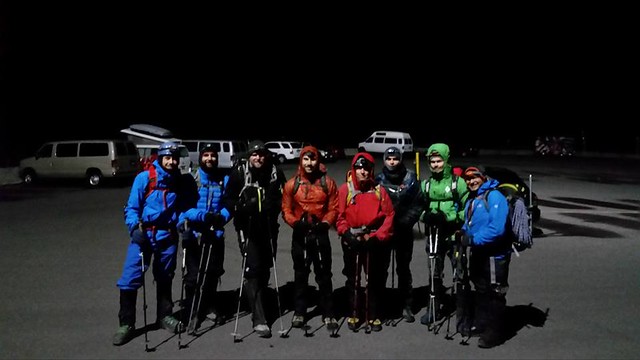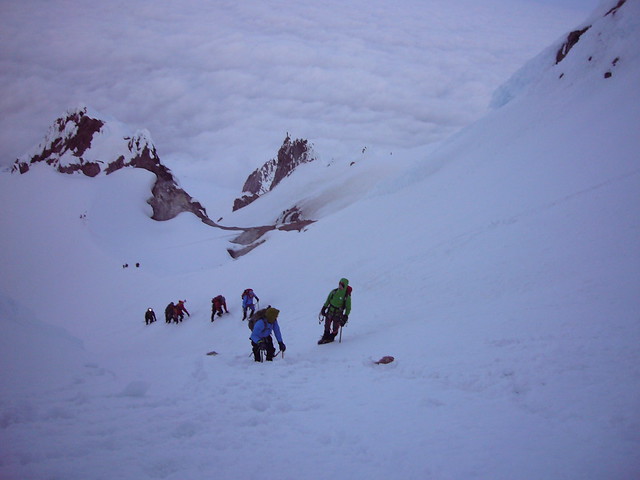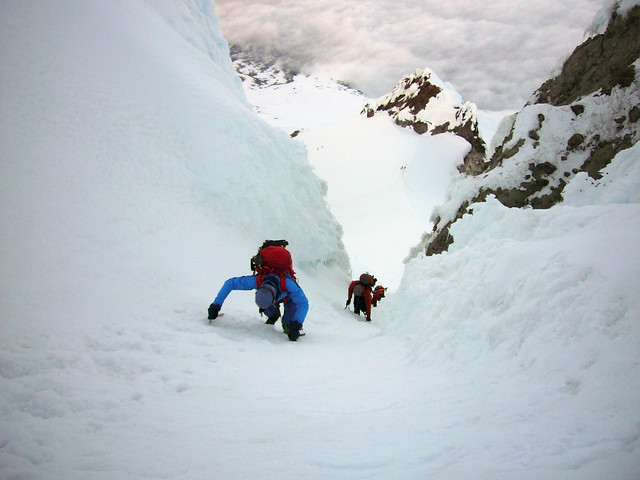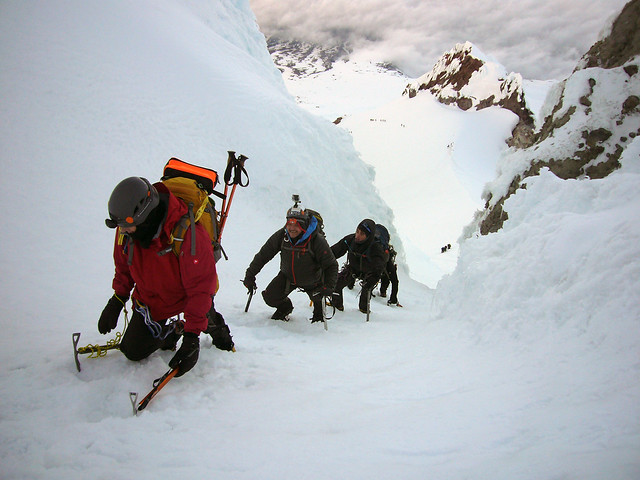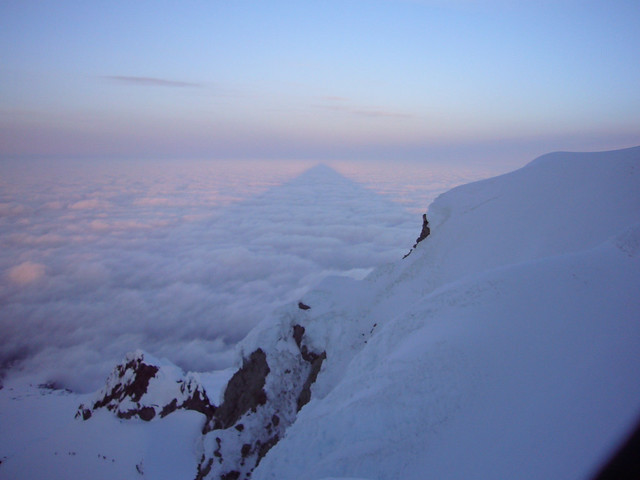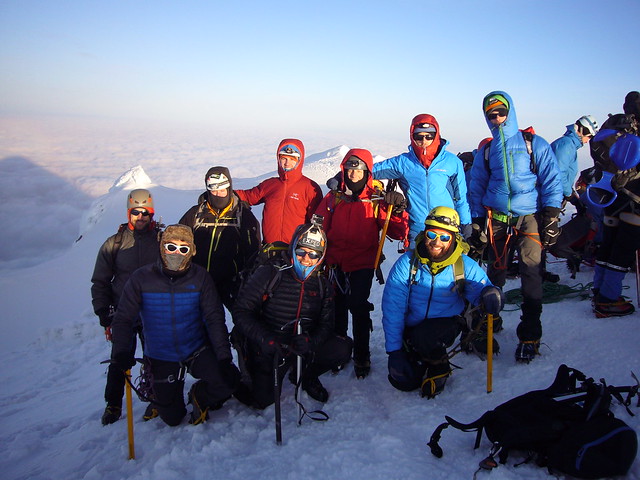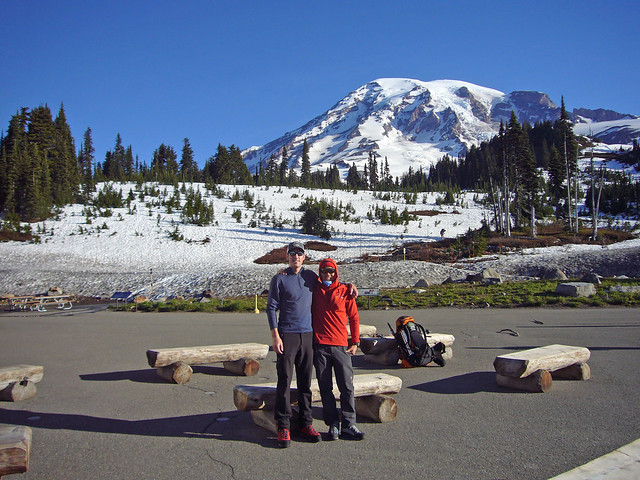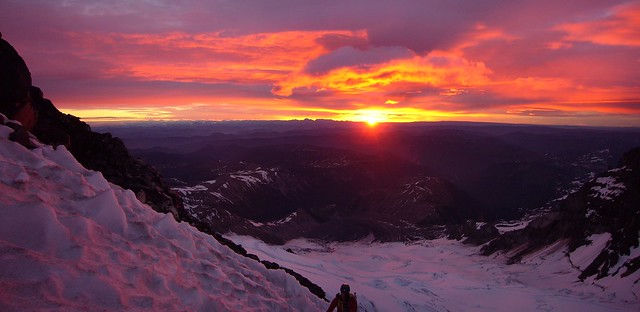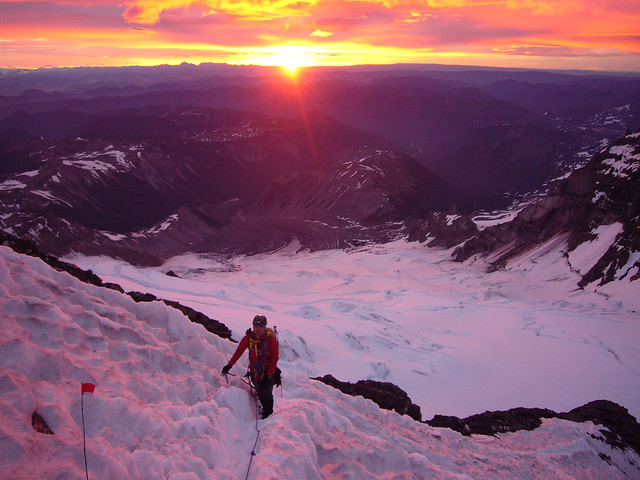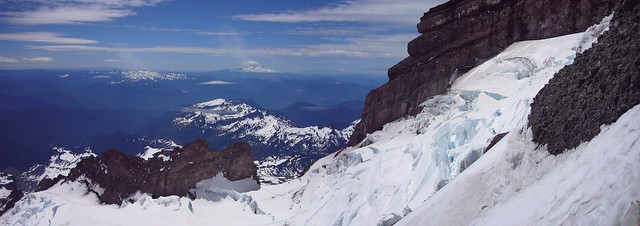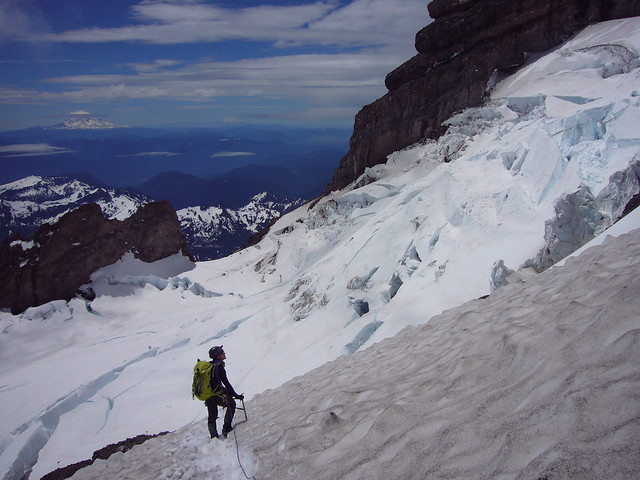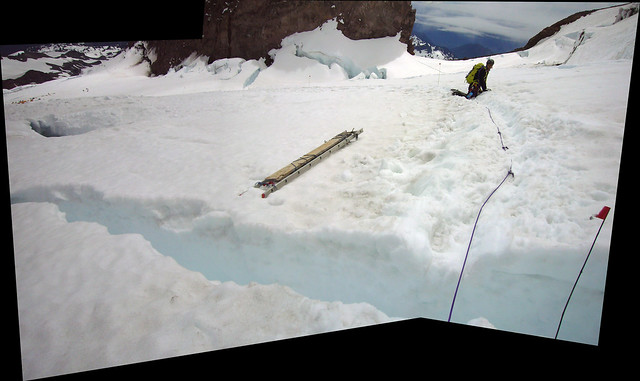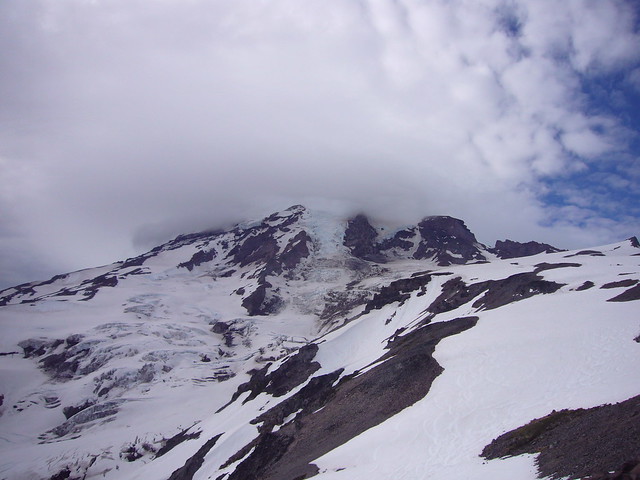During the annual SAC Luau, a couple of us talked about climbing Mt. Rainier one more time before the weather got worse. Of course I was interested. It turned out that only Peter and I could make the climb, so we decided to stick to the standard Disappointment Cleaver route, which was likely to have many other people on it, in case something bad happened. We decided to do the route with a twist, though, camping in the summit crater.
Peter was training for Aconcagua in December and climbing high with heavy packs and sleeping at 14,300 feet would be good practice for his trip. And I'm always up for new adventures. We opted for a similar start to our previous trip in June, taking Friday off of work and spending the night in the Paradise parking lot to begin our acclimatization.
The forecast for the weekend was for a mild high pressure system to move over the mountain Saturday and Sunday, with a chance of rain on Friday. We woke Friday morning to steady rain, some of which had seeped through my tent. Luckily, I'd used a spare tent and sleeping bag Thursday night, so my good bag and our tent were dry and ready to go for our climb.
We started out in full rain gear, plastic trash bags pulled over the tops of our packs, around 8 am. The rain had backed off a bit and was relatively light for the first part of the approach. Despite the fact that I'd climbed the mountain two other times this summer the mountain looked totally different. The snow had completely melted on the lower mountain and the valleys we walked through were lush and green. I didn't take much time to appreciate them, though, as we kept moving to get to camp Muir and cover from the rain as quickly as possible.
As we got closer and closer to the ridge and the Muir snowfield, the wind began to pick up until eventually the rain was being driven sideways at us. I'd managed to stay dry for the first several hours, but eventually, rain began to seep through the side zippers on my pants.
Visibility as we moved into the clouds became dismal and the recent snow made route finding challenging. We continued upward in the general direction where we felt camp Muir must be. All the while, we hoped for the driving rain/slush mix to turn to snow and relieve us from the relentless wetness we'd been climbing through for hours. It didn't change until we were almost at camp Muir.
I didn't take my first picture until we made it to camp Muir.

It took us around 5 hours to make it to camp Muir and the shelter of the public hut. The first order of business was to get warm food and rest a bit. Soon after that, we unrolled our sleeping bags to take naps. We both discovered that the trash bags we'd had over our packs had done little to keep our gear dry. Almost everything was wet. I tried to nap for a while in my sleeping bag, but the once lofty down had become soaked and was reduced to cold, clumpy balls, doing little to insulate me. I worried that if my bag didn't dry out, I wouldn't be able to risk spending a night on the summit in the ~10° temperatures.
When I got up later that afternoon, having been unable to sleep. I discovered that the National Park Service workers (who were constructing a new bathroom) had made a barrel fire. Peter and others were already gathered around it drying out various articles of clothing. I brought out my sleeping bag and spent the next two hours holding it next to the barrel attempting to dry out the down as much as possible. It was partially successful and I managed to bring a bit of loft back to the 40 year old bag.
Because Peter and I planned on camping on the summit and didn't need to make it back to camp Muir on Saturday, we had the luxury of planning a relatively late start time. We woke up the next day around 5 am, well after the hordes of other climbers had left between midnight and 2 am.
We were elated to wake up to calm, clear skies and relatively warm temperatures.
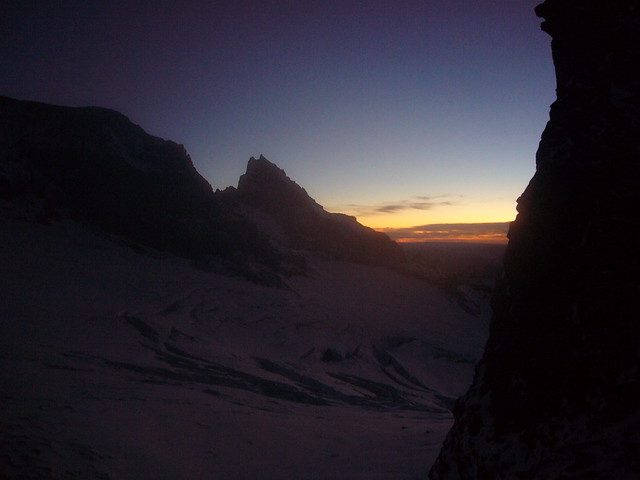
We took our time eating breakfast and packing, not roping up to begin the climb until 7 am.
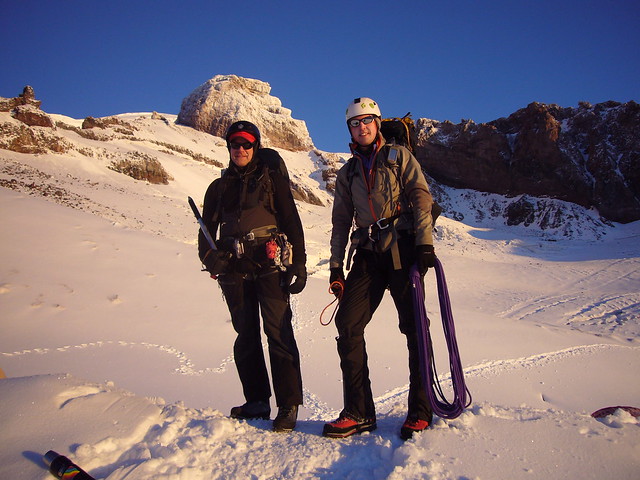
One advantage to the late start was that the groups ahead of us would be breaking the trail. Because of the snowstorm from the previous several days, no one had been on the upper mountain for the last three days. A couple feet of new snow covered the old boot pack. Avalanche concerns were realistic with the fresh snow. On our way up the freshly made trail, the guided groups ahead of us had dug avalanche pits to test the snow's stability on each dangerous slope. The snowpack turned out to be quite stable.
The fresh snow covered the dirty glacial ice and snow, making for beautiful scenery.
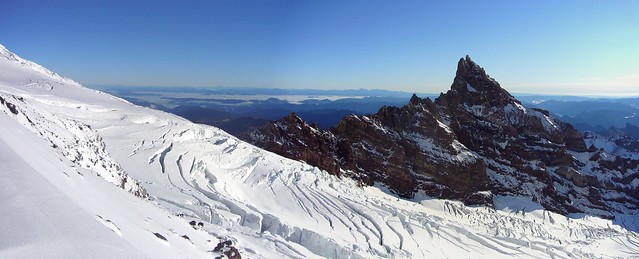
The fresh snow also made the climbing easier. Cathedral Gap and the Disappointment Cleaver, which would have been loose, rocky scrambles a week earlier were now relatively stable and easy to kick steps into.
The crevasses had really opened up since my climbs earlier in the year.
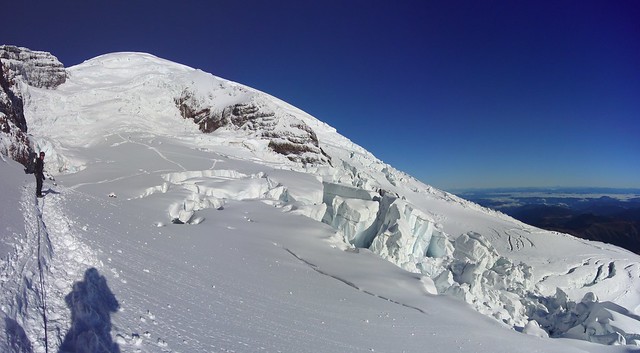
The trail heading towards the Disappointment Cleaver in the background.
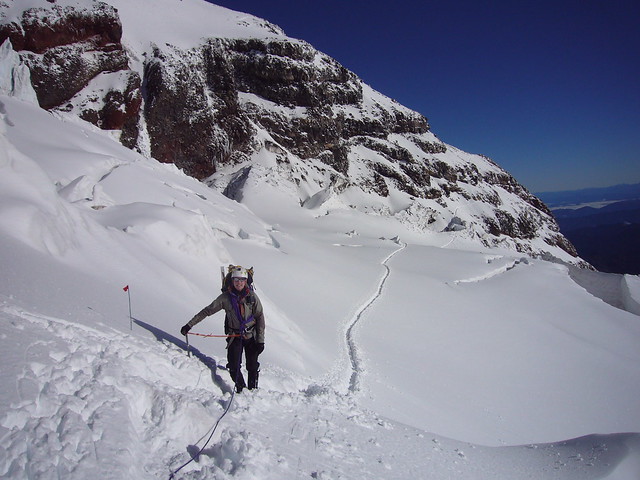
The 6+ inches of rime ice on this ladder give an idea of the conditions we'd climbed through the previous day on our way to camp Muir.
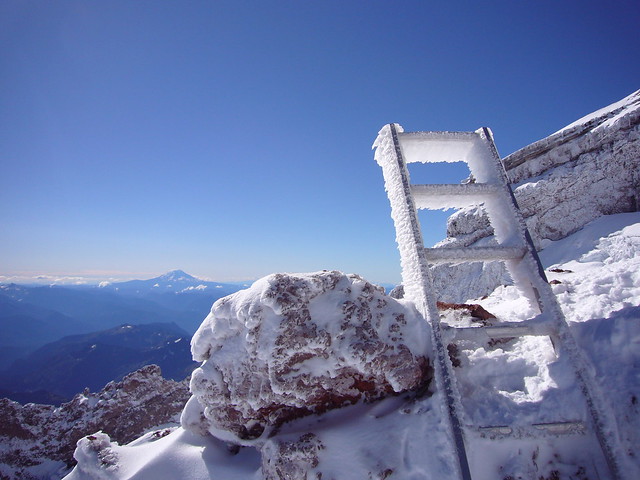
With fully loaded packs (~50 lbs) and a relaxed attitude, it took us nine hours to reach the summit crater, about the same amount of time it typically takes to make the round trip between camp Muir and the summit. As many of the descending groups had told us, there was very little wind "on the summit." When we reached the crater rim, though, we discovered that none of the other climbers had actually reached the summit that day. They'd all stopped on the far side of the crater.
Here's a tricky shot of Peter and I in the summit crater at the site of our new home for the night.
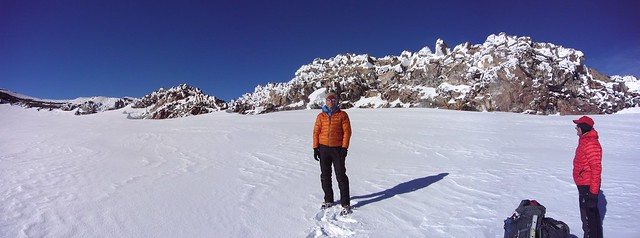
We spent the next couple of hours setting up camp in the snow, melting snow for water, and rehydrating our freeze dried meals. We crawled into our sleeping bags to rest around 6 pm. Five minutes later, I realized that if I wanted to see the sunset from the summit, I'd have to begin the trek immediately. I debated for a couple of minutes, but decided I'd come too far and worked too hard to skip out on the last bit.
The temperature had plummeted since the sun went below the ridgeline (my water bottles were already freezing solid inside the tent). I put on every layer of clothing I had brought, including my new, giant down mittens, then set off for the summit, another 100 vertical feet above us and quarter-of-a-mile away.
Halfway to the summit, I turned around to get one of the best views I've ever had on a mountain. I'd been miserable near the end of the climb to the crater, but this view reminded me exactly why I put myself through such miserable conditions. My pictures don't even begin to do the view justice.

Click on the panorama to make it bigger. You can see the shadow of the mountain cast by the sunset and the little yellow speck that is our tent.
Mt. Rainier still has hot spots, and is venting steam. All the way around the glacier in the crater of the summit, steam vents melt the snow and ice and cause voids underneath it. As I started to cross the edge of the snow to get onto the rocky crater, I could here the snow cracking, like ice on a thinly frozen pond. I was worried about breaking through, so I got down on my hands and knees and crawled the last few feet to the solid ground.
When I finally reach the ridge of the crater that led to the summit, I realized the sun was almost below the horizon. So, at 14,400 feet, after climbing all day, I sprinted the last 50 meters up the ridge to the summit. I've never breathed so hard in my life. But the view was worth it.
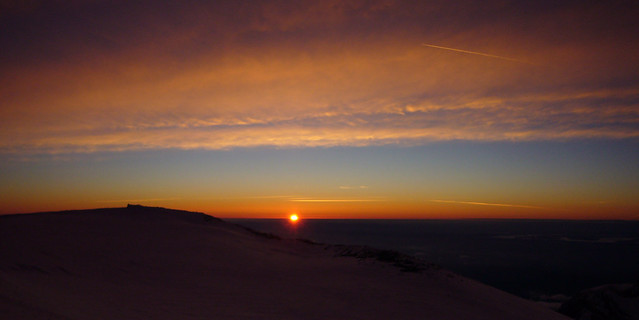
I was the only person to stand on the summit of Mt. Rainier that day. Here's my lonely set of footprints to and from the summit (taken in the morning).
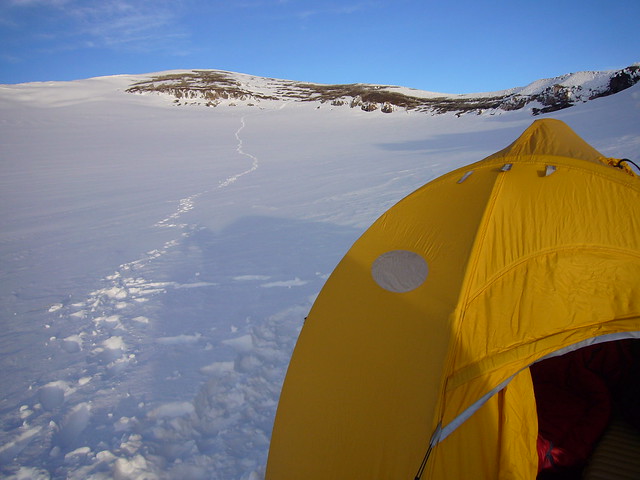
After I got back from the summit, Peter got dressed and we headed down under the glacier to explore the ice caves. The aforementioned steam escaping the crater has made a huge network of ice caves. Peter has explored them before and part of our plan of camping on the summit was to have time to explore them again.
The steam flowing through the ice caves made it difficult to take pictures because the flash reflected off of the mist. We took a video instead. We traveled through a couple of narrow passages before reaching a large room and turning around. Where the steam vented out of the ground, the surrounding rocks and air were so hot you couldn't keep a bare hand next to them. The air temperature was probably between 40-50 degrees, 20 or 30 degrees warmer than it was outside.
That night was cold. I slept with all of my layers on and kept a water bottle in my sleeping bag to keep it from freezing. My second bottle froze solid, nearly bursting my Nalgene. I also hadn't managed to dry my sleeping bag completely. There were still clumps of wet down in my bag, which quickly froze and turned into ice balls. I stayed warm by covering the thin spots in my sleeping bag with an extra fleece I'd brought. I'm not sure I slept at all that night, mostly because of the low amount of oxygen in the air at that altitude. Needless to say, I was very happy when the sun finally started to rise.
Again not in a hurry, we waited until the sun rose above the ridge of the crater to really start moving. We ate breakfast, melted snow for water, then packed and headed down from the summit just after 9 am. The first groups of climbers that left camp Muir that morning had already summited.
The climb down was straight forward. We had a good trail and great weather. We stopped for an hour or so at camp Muir to rest, melt a little more snow for water, and eat a little before finishing the trek back to the car.
We enjoyed spectacular views of the mountain, glaciers, and gaping crevasses on the way down.
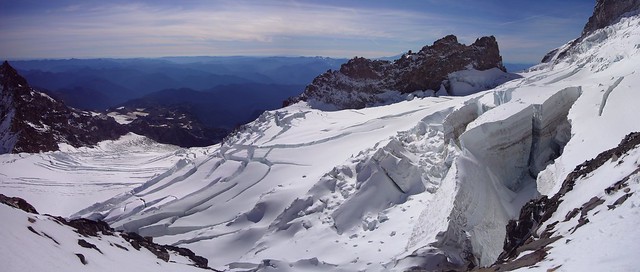
If you look closely, you can see the trail to the left, below the Ingraham icefall.

Here's a ladder crossing a crevasse.
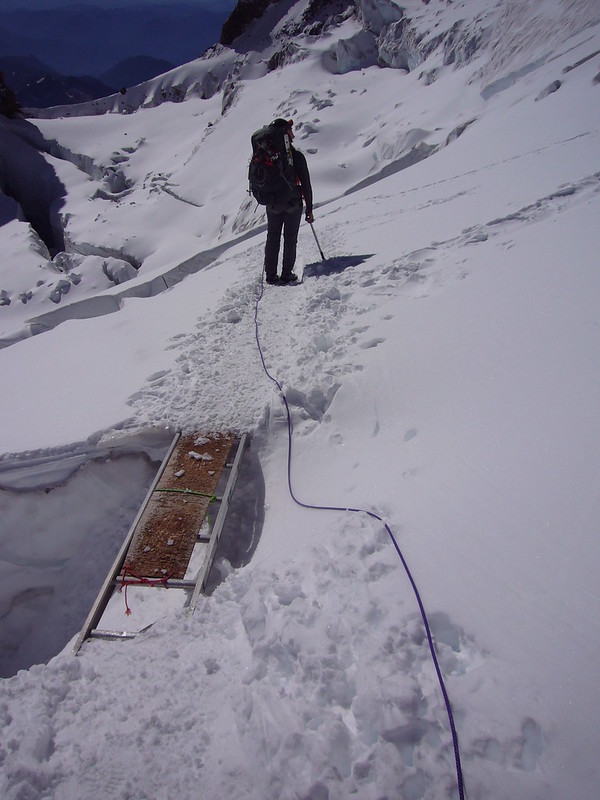
In stark contrast to our ascent on Friday, we had gorgeous weather for the hike out on Sunday. The lower portion of the mountain is beautiful and I was able to see it as I'd never seen it before.
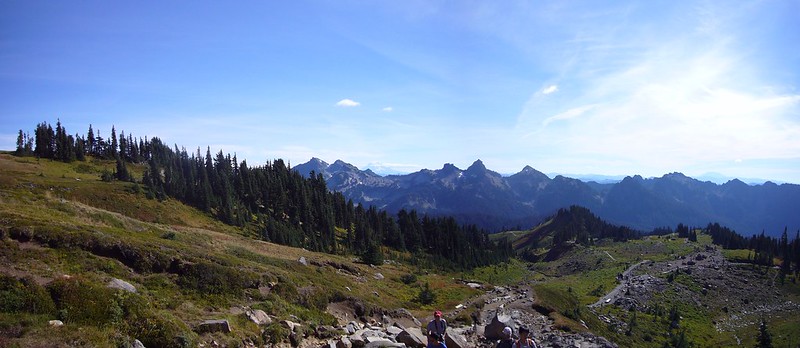
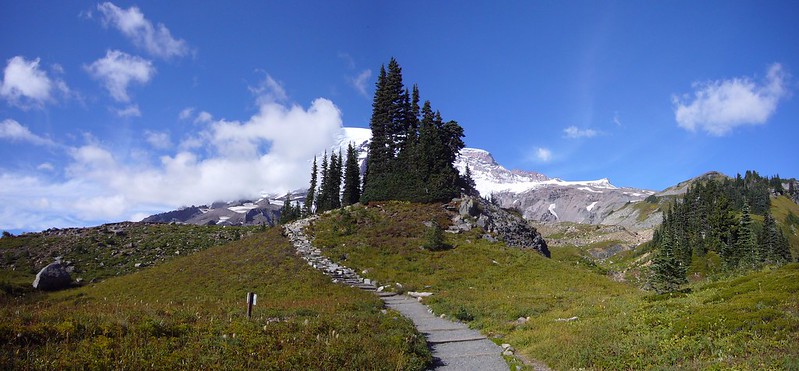
The best pictures from the trip are on
flickr.
